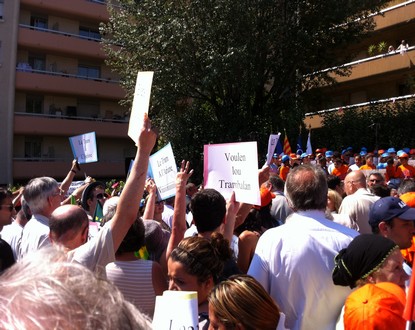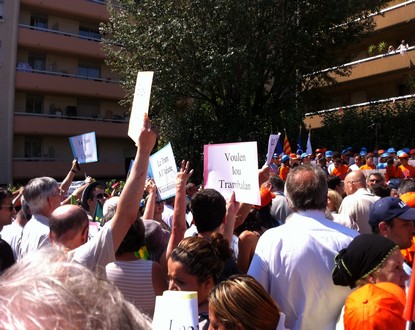Since yesterday, the day of its inauguration*, it is now possible to take the tram to Pasteur. By crossing the Paillon, the tram brings a breath of fresh air to a densely populated neighborhood.

This new extension will soon connect the new Pasteur II hospital upon completion of its construction and after its commissioning.
But when it comes to “tramway” today, it touches on a delicate subject: In addition to the ongoing controversy surrounding line 2, a new chapter has just been added, that of the extension of line 1 to Ariane and La Trinité.
It was this that the protesters reminded the Mayor of Nice, as they brandished signs with an array of slogans, bringing themselves to the neighborhood’s celebration for which the municipality had mobilized the neighborhood committee and numerous associations to create a festive scenario.
These protestors thus allowed Patrick Allemand, leader of the municipal opposition but present as Vice-President of the Region, to speak about this theme as a future objective.
But they also provoked an animated reaction from a noticeably agitated Christian Estrosi, who countered by arguing for the option of reorganizing the regional train line (which already runs from Nice, Thiers station, to La Trinité) with urban stops and frequencies.
A train that serves as a tram? Unheard of, but there is always a first time. The idea is far from ludicrous. Is it feasible from a technical standpoint?
Thus, following the extension of line 1 to Pasteur, which everyone acknowledged for its positive impact, a new front is set to open concerning the arrival of the tram at Ariane and La Trinité.
A dossier that promises to be delicate and is likely to become increasingly engaging. With municipal elections approaching fast, any argument will be good to oppose and create controversy.
Is it right for this to happen at the expense of citizens who only demand better public facilities? That is another question.
Moreover, the General Council, in its mobility and transport plan distributed on this occasion, specifically mentions this option as a strategic goal. Could there be a divergence between the two authorities?
Christian Estrosi, who has the power, instead of directing the residents of these neighborhoods to take the train for lack of a tram, could apply his favorite maxim to himself “I do what I say.”
In fact, what’s the use in turning it into a political tug-of-war with his opposition but especially with the residents of these districts who have certain rights? Why not start with a route to Ariane and then, in a subsequent phase, arrive at La Trinité, which is already served (albeit not optimally) by the train?
If Emmanuel Kant said “man is what he does”, Christian Estrosi, having become Keynesian through his economic action, might well find himself Kantian in his behavioral action.
Keynes, Kant, what noble inspirers… Who says better?


